My brother was a builder and a destroyer. He is four years older than me, and we never were close. That’s something, as we both age, I regret. One of my earliest memories is my brother inviting other kids over to watch 8mm family movies in our back room, an extra room on our small mid-century house that included storage space, the oil tank, and everything else typically found in an attic or basement. Our house had neither; it was built on a concrete slab that contained water pipes, and water from the central heater located exactly in the centre of the house heated the floors. This was a remarkable thing in the 50s. The roof was flat, with only a slight angle to control rain and melting snow. It was one of three houses built on our street that were all exactly the same. There were to be two, but my grandfather walked across the street one day to talk to the construction team and arranged to make it three, with the third house located on part of his property.
What bothered me about the movies, which kids paid 10 cents or so to watch, was that most of them seemed to be about my brother throwing snowballs at me, hitting me in the face with snowballs, or shoving snow down the back of my jacket. I wondered, and still wonder, who was taking these movies and why on earth they didn’t stop him. There were several different variations of my brother doing this. The movies even had cliffhangers… a snowball gets thrown… “to be continued” on the next tiny plastic reel.
I guess, in a way, I had his full attention. One night, after the family had gone to see Hitchcock's The Birds (I cannot explain taking a 7-year-old to see this movie), my brother set up his record player in the closet and waited for the right moment to plug it in from his bed. He had a 45 on it all ready to go…with some teenage angst song that started, as a teenage summer angst song might, with the sounds of birds calling each other! I went running out of the room to his quiet enjoyment.
I remember going into second grade, and other kids, who all seemed to have brothers the same age as mine, were being assured by them that grade two would be fun, it was a good class and that they would like the teacher. My brother told me to believe none of it, because secretly Mrs. Sullivan, the second-grade teacher, was a witch… and kids she didn’t like “disappeared.” It took me a while to related to Mrs. Sullivan.
Later in life, my brother made it a practice to take advantage of people outside the family, becoming an audio-store bill collector, then a bill collector for a bank… and now he’s a real estate agent. What can I say? He seemed proud to be our own Snidely Whiplash. He often told stories of knocking on doors and taking people’s TV sets out of the house, or how he would get keys to their car and drive it away. He loved the power he had over others.
Once, he drove his VW Bug onto the ice-covered pond with a boat tied to the top of the VW, full of his friends. Hitting the brakes and twirling around… until he discovered the ice wasn’t that thick yet, and they all had to abandon ship. He then demolished the new family car by smashing it into another vehicle… a few times. “Oh, the brakes didn’t work.” There was always an issue.
That, I’m afraid, was the extent of our relationship, except for one episode I want to share: The tunnels.
My brother started digging tunnels in the abandoned lot next door. Apparently, at some point, the neighbours used the lot to grow flowers for local flower shops and cedar bushes for people's yards. This property was owned by a family consisting of an older mother, who everyone sent their kids to when it was time to learn to tie their shoes, her son, who my brother seemed to have a dislike for, and a daughter who visited occasionally. The gardening enterprise had long since shut down, and the bushes had grown into cedar trees, about 6 feet tall at the time. But for my brother the cedar trees provided a screen to hide his work. He started to dig. First, there was a five- or six-foot hole. Then he dug a tunnel towards the street, which led somewhere to a larger room, the “bunker,” that I remember he and his friends excavated. I think you could actually stand in this room.
He had plans. He wanted to dig under the dirt road into the neighbour's yard. A couple of my friends and I were requisitioned to dig in the holes. We had lots of tools, nearly emptying my grandfather's tool rack in his garage, and there were the Boy Scout shovels as well. Military green, with a folding handle that made them easier to carry on a backpack. This went on for some time. I’m not sure how my father discovered the project, but let’s say one day he “unearthed” the plans.
Every year, my father would rake all the leaves together and mix them with dirt. Any leftovers were burnt. Back then, everyone burned leaves all through the fall. Most people also lit their lawns on fire at the end of the season. This pile of lawn and maple tree leftovers was where garbage and vegetable cuttings were thrown, mixed with dirt. By midsummer of the following year, it would have been covered in a blanket of green with squash, tomatoes, cucumbers, and watermelons. Worms for fishing were also plentiful. This summer was a bit different; after discovering the hole, my father used the grass cuttings and leaves to fill the hole. He then covered it all with part of the dirt from the excavation. My brother kept quiet during this entire process. You see, there was a problem my brother failed to mention. My father didn’t realize that he had buried all his and my grandfather’s tools, which were missing, and were, yes, inside the hole down in the “bunker.” All lost, I suspect, until the lot was excavated for a new house about twenty years later.
Years after I went back to this little woodland and took a walk through this tiny forest. The dirt pile was still visible beneath the underbrush. And there was a two-foot or so depression where the large room, the bunker, had been. The woodlands around the neighbourhood have a lot of these depressions, from hidden underground rooms to simple dugouts made by kids and teens. But none were recent. I guess moving underground is no longer a goal of teenagers. During the Cuban Missile Crisis I always thought an underground bunker was a pretty good idea.
These structures, dug outs, nailed, half-finished, and long abandoned, got me to see the world in terms of process and impermanence. And it’s that sensibility, rather than any interest in classic composition, or decisive moments, that guides how I photograph now. Taking a trip home with your camera you have to decide, do I want to capture the past, fill your camera with nostalgia, or use the camera to experience the often welcome, slight sadness, of what was?
I started this essay with this family story, and like most stories, it’s made up of very specific events, critical moments and experiences, and details which are of pivotal events. A snowball in the head, a car sinking through the ice, some missing tools, even descriptions of the types of shovels we used. In photography, we would call these “decisive moments.” And we look for them, wait for them and try to catch them. But that’s really like catching a breeze.
Which brings me to watching Richard Linklater's movie Boyhood.
A favourite movie of mine, but also a difficult movie. Very different in its structure than other stories. It just doesn’t flow like you would expect a movie to flow. from pivotal event to pivotal event. It’s oddly missing these big events in some way, we are there, but they just aren’t important. If you aren’t familiar with it, the film was shot with the same cast over the course of twelve years. It’s takes place in several different settings, different houses, rooms, schools. Different parents as his mother gets married and divorced a few times, as does his dad. People come and go. When they leave, they are just gone. Most of all, as you’re watching you realise these places, where the limited action takes place, are almost unimportant. They seem to merge into one another. The timeline goes back and forth, and doesn’t seem propelled by anything in particular. Life just happens, and we watch. And even though the movie is slow, after a while you know that, in a very little while, life and the story will have moved on.
The dugouts, gone, the tree forts, gone, the holes people dug will be filled up and covered over. Only a slight depression, visible because you know to look. It too will fade. Rooms will be empty. Its visual language embodies the Japanese aesthetic concept I write about so much: “mono no aware”—literally the pathos of things, the bittersweet awareness of the impermanence of all things. Using the same actors, and seeing them change, age, and become different, their bodies, hair, and voices all change. Watching not them as much as time moving on. Unstoppable. Pathos.
Durational Witnessing
Through its deliberate rejection of conventional photographic ideals the movie embraces of what the director calls “durational witnessing.” The film transforms the ordinary passage of childhood into something profoundly moving, capturing fleeting moments with the gentle melancholy that really defines “mono no aware.” It is a sense of missing that is gentle, expected, and often is noted best when we just watch, and don’t intervene. It’s a very different feeling about remembering than my story about my brother.
Against the Decisive Moment
To understand Boyhood’s revolutionary approach to time and image, you have first to recognise what it explicitly rejects: From a photographic point of view I would say that’s the Western photographic tradition of the "decisive moment." Henri Cartier-Bresson's famous concept suggests that photographers should hunt for that perfect instant when all elements converge into meaningful composition, a moment of mastery over time itself. This approach, with its emphasis on capturing and possessing the perfect moment, and the photographer’s “skill” at that, runs counter to what we experience watching Boyhood. You’re asked to let go, and just watch.
Problematically, the decisive moment ideal often relies on artifice. And many of photography's most celebrated "spontaneous" moments were staged, repeated, and manipulated until they achieved their supposed perfection. This quest for the ideal moment reflects a Western desire to freeze and control time, to extract permanent meaning from the flowing stream of experience.
Boyhood operates from an entirely different philosophical foundation. Rather than hunting for decisive moments, Linklater practices what some people call "durational witnessing.” The camera doesn't seek to capture perfect convergences, but accompanies the main character, Mason, through the ordinary flow of time. The film's power emerges not from any single crystalline or perfect image but from the accumulation of imperfect, unremarkable moments that gain profound meaning through their very transience. What do we experience? A haircut, a family fight, being at a bowling alley and not having a good time, a birthday cake. Often, the participants are paying less attention than we are, looking up at the sky, turning away while listening, giving answers that don’t solve situations. If you pay attention to 1960s and 1970s photography , such as the New Topographics show, you recognize these quiet moments as essential to a good photograph. And seldom do they appear to “capture” a moment.
An Aesthetics of Accompaniment (Documentation and Truth)
The film's cinematography functions as a form of visual accompaniment rather than visual capture. You are like a patient friend walking alongside Mason through his childhood, the camera maintains a consistent, observational presence without demanding that each moment justify itself through dramatic significance or visual perfection. The emphasis is on being present with whatever is occurring, including and especially its flaws and ordinariness. What’s great is the film doesn’t just talk about this philosophically….as I often do, it demonstrates how to do it and what you end up with if you do.
Consider how the film handles what conventional cinema would treat as "decisive moments”: Mason’s first kiss, his high school graduation, his departure for college. These scenes aren't dramatized with close-ups or heightened cinematography but are captured with the same gentle, observational eye as homework sessions or car rides to school. This even-handed treatment suggests that all moments possess equal weight in the flowing stream of experience, and that attempting to elevate certain moments above others misses the deeper truth about how life actually unfolds. When I studied Zen Buddhism with Masao Abe we would call this “Dependent Origination.”
This lesson, I believe, is a crucial one for anyone seeking to create meaningful images in a narrative style. It explains so well how some people (like me) end up thinking about Alec Soth and narrative photography, and the thought occurs: what is necessary for the next image? How do I order these images for a dramatic effect? Instead, these are images that tell a story open to the viewer, rather than being closed and directed by overpowering composition, style, and demonstration of technical skill. Unlike traditional photography and cinematography, which seek to freeze moments into permanence, or conventional cinema, which constructs time through editing and dramatic structure, the film allows time to accumulate naturally within and between frames. Something anyone holding a camera should learn to do.
The film demonstrates that the most profound experiences often occur in the spaces between dramatic events, in the accumulation of ordinary days that only reveal their significance through the collective passing of time.
Boyhood, for me, stands as an example of how photography and cinematography can embody philosophical concepts through technique rather than theme. The result is not merely a movie about growing up but a meditation on the nature of experience itself, a reminder that life's deepest meanings often emerge not from moments of perfect clarity but from the patient witnessing of ordinary time as it flows, irretrievably and beautifully, away from us.
……………………………………………………………….
All of the photos are© Jim Roche, all rights reserved
They come from a large series of images of forts, holes and structures built in the woods.
You can visit my webpage at www.jimrcohe.ca
Do films influence your work? Specific techniques? How? I’d like to hear.
…………………………………………………………….
Now, take all those rules, throw them down the hole my brother dug, throw in some leaves, and top it with soil. Get rid of them.
.




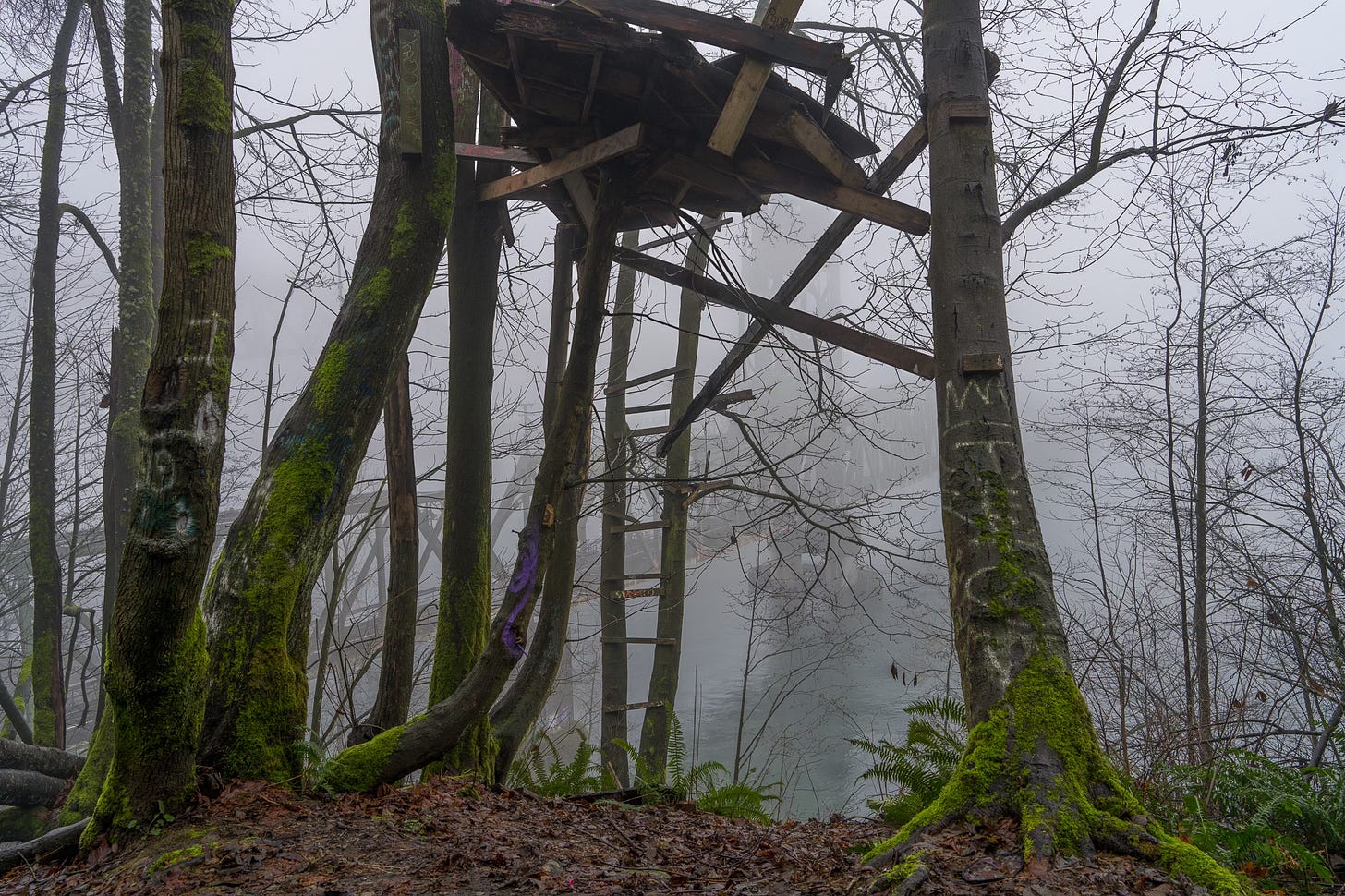

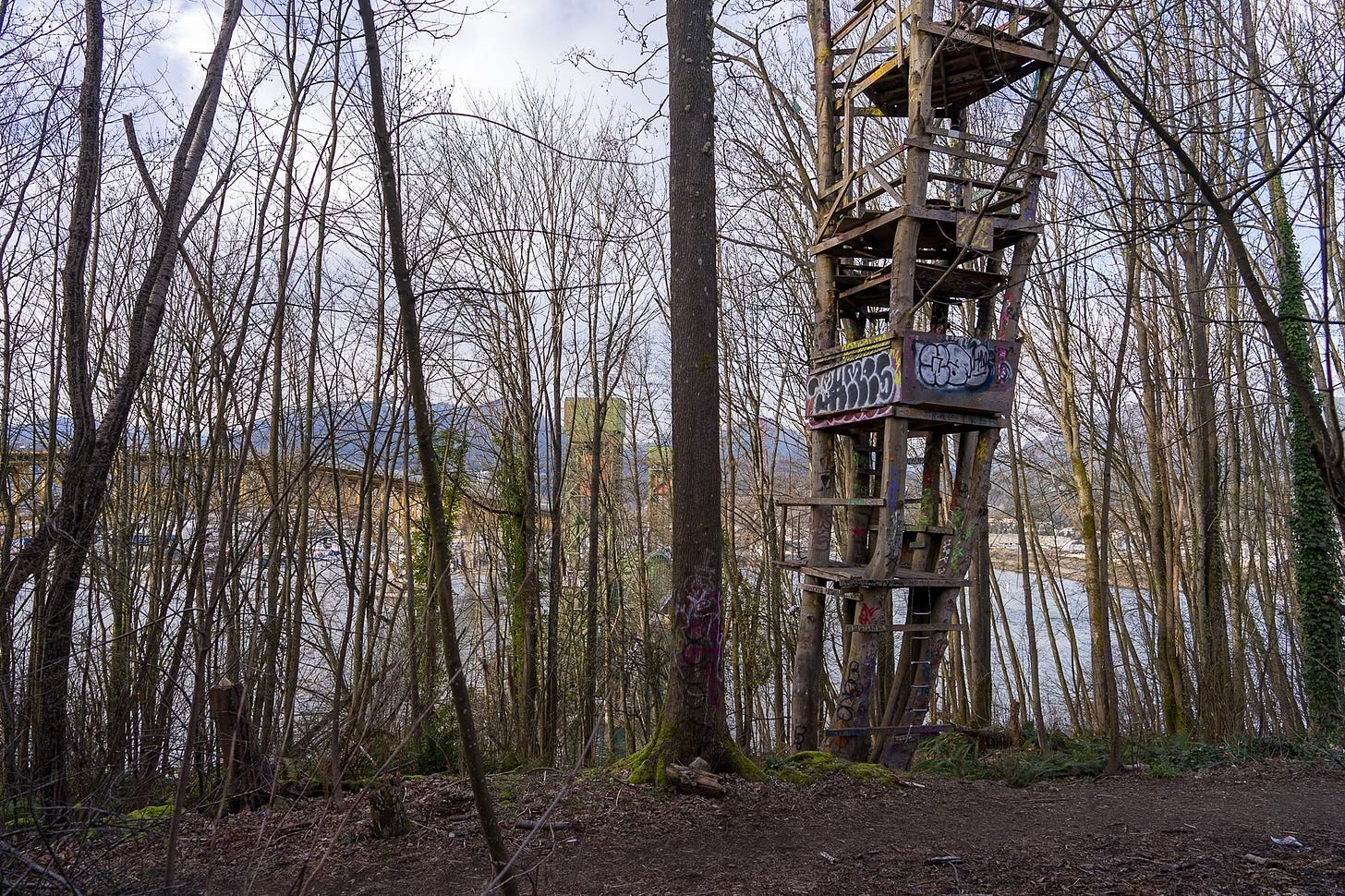

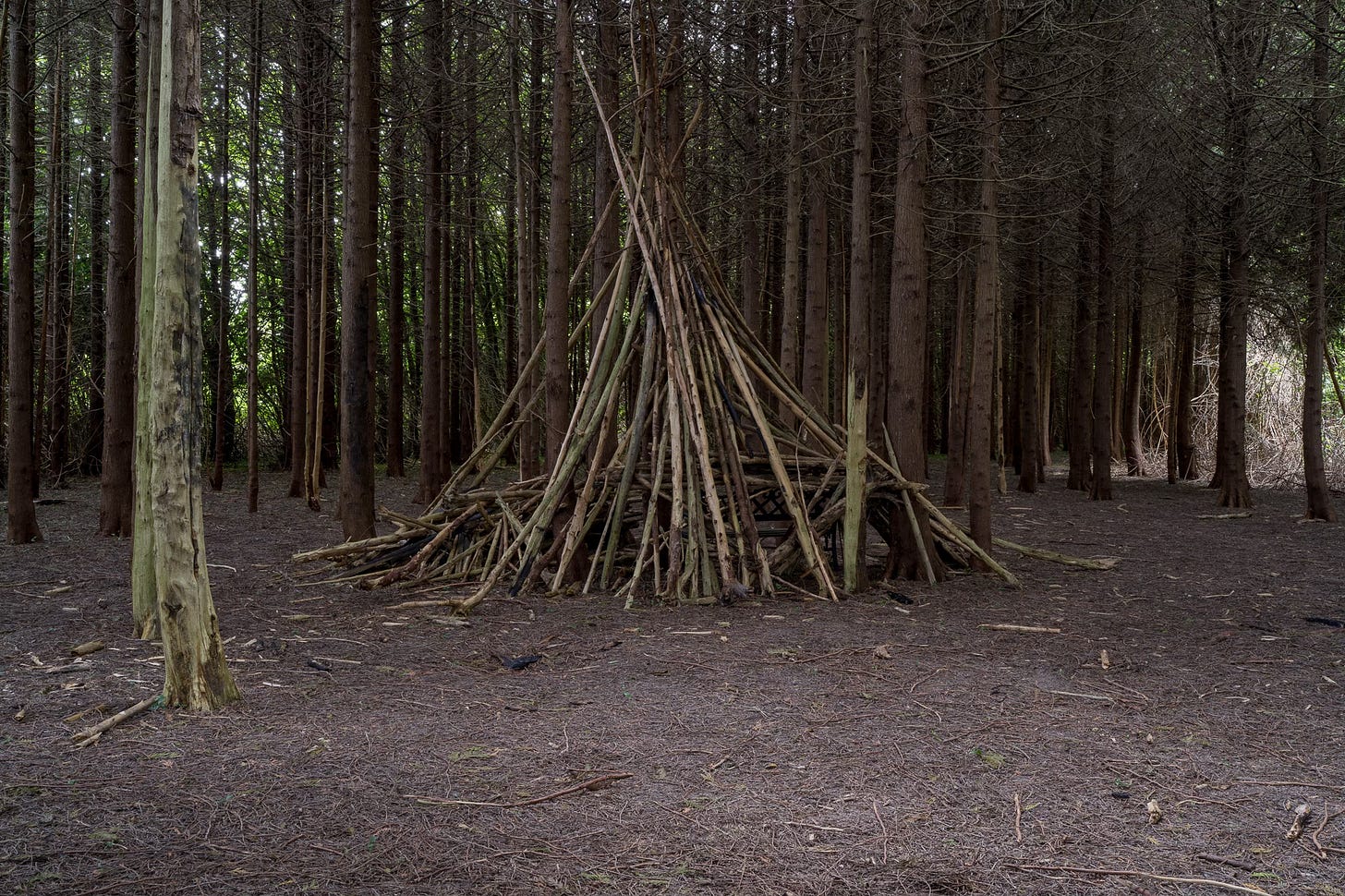
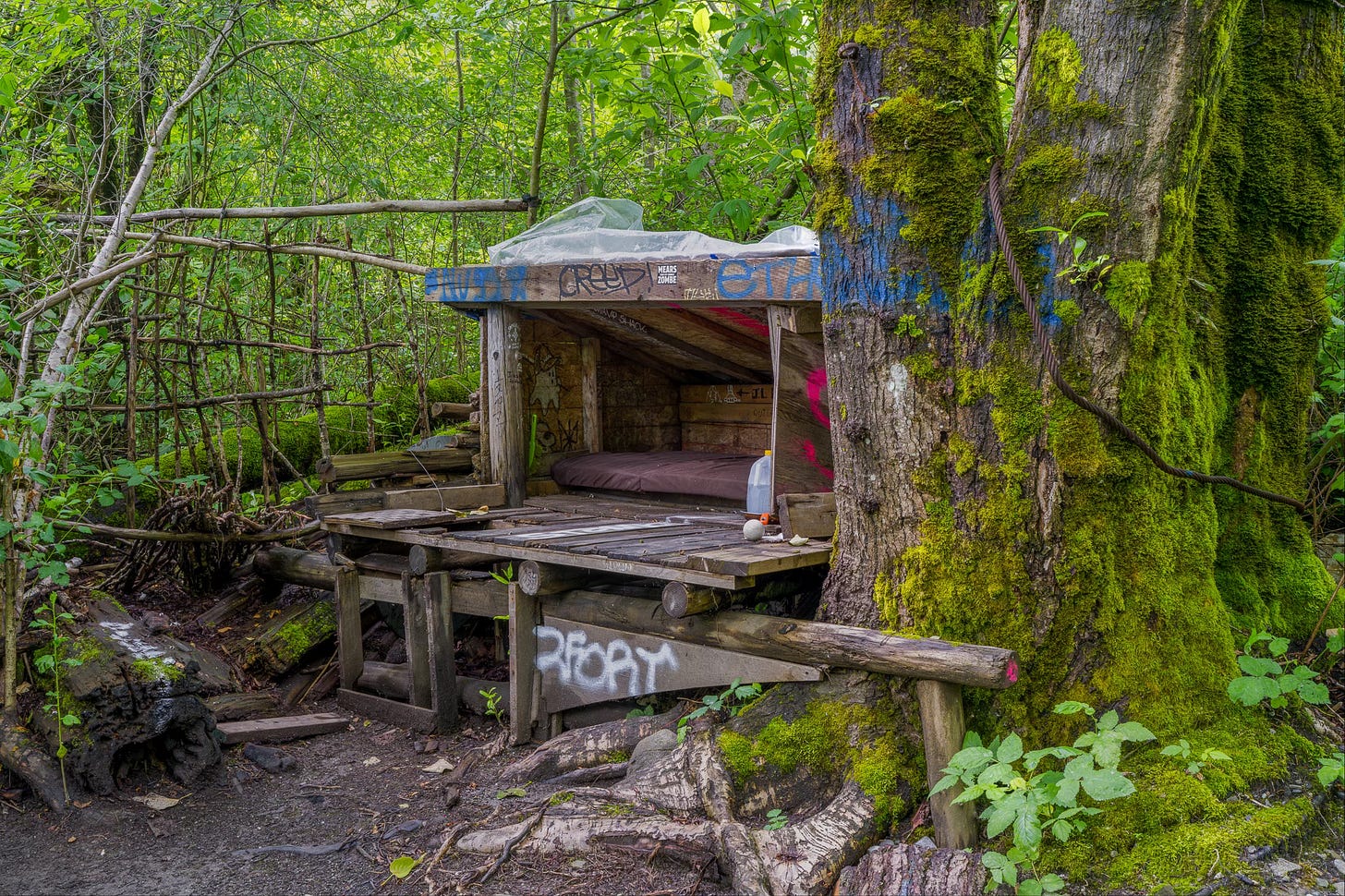

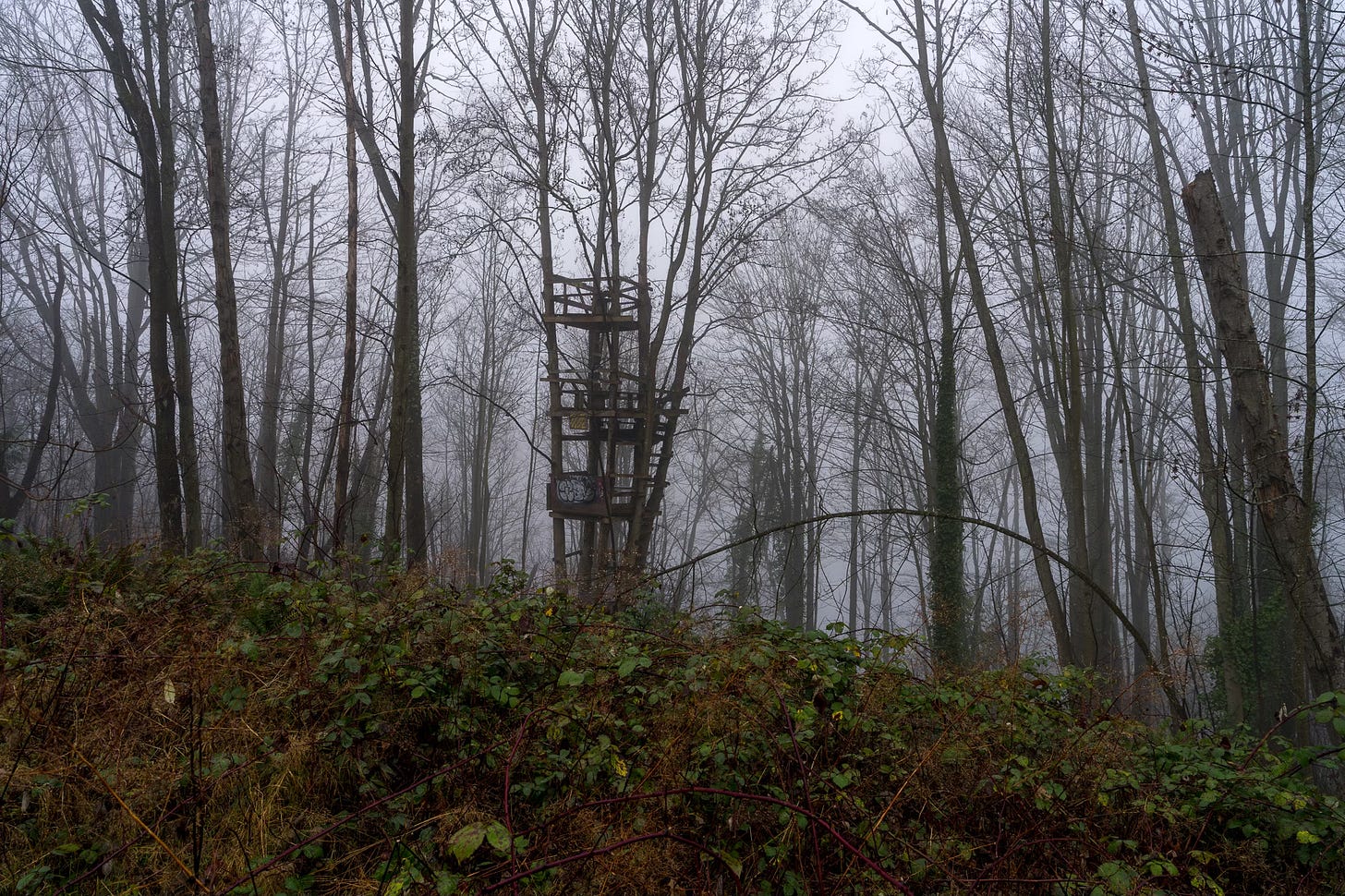
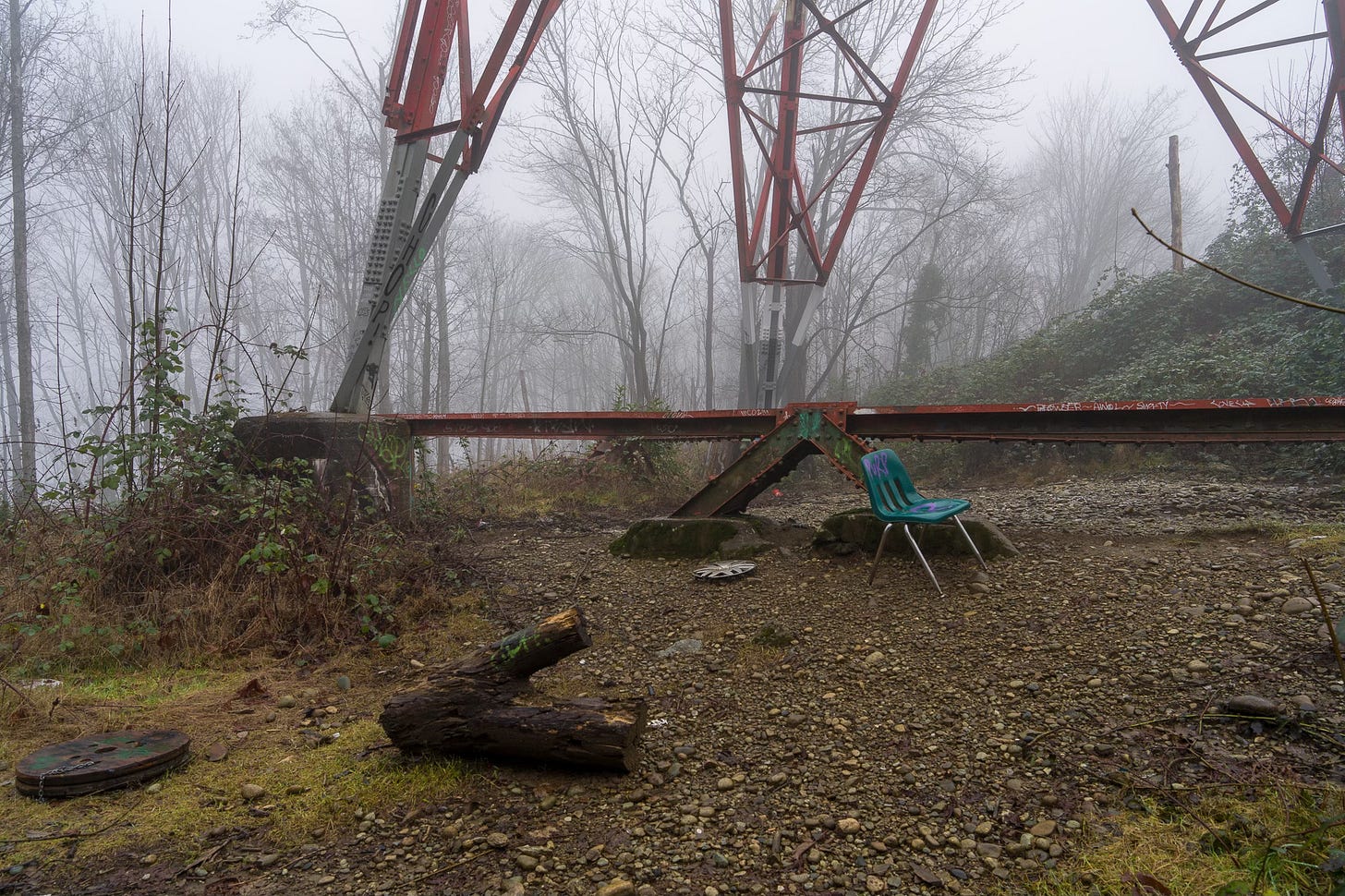
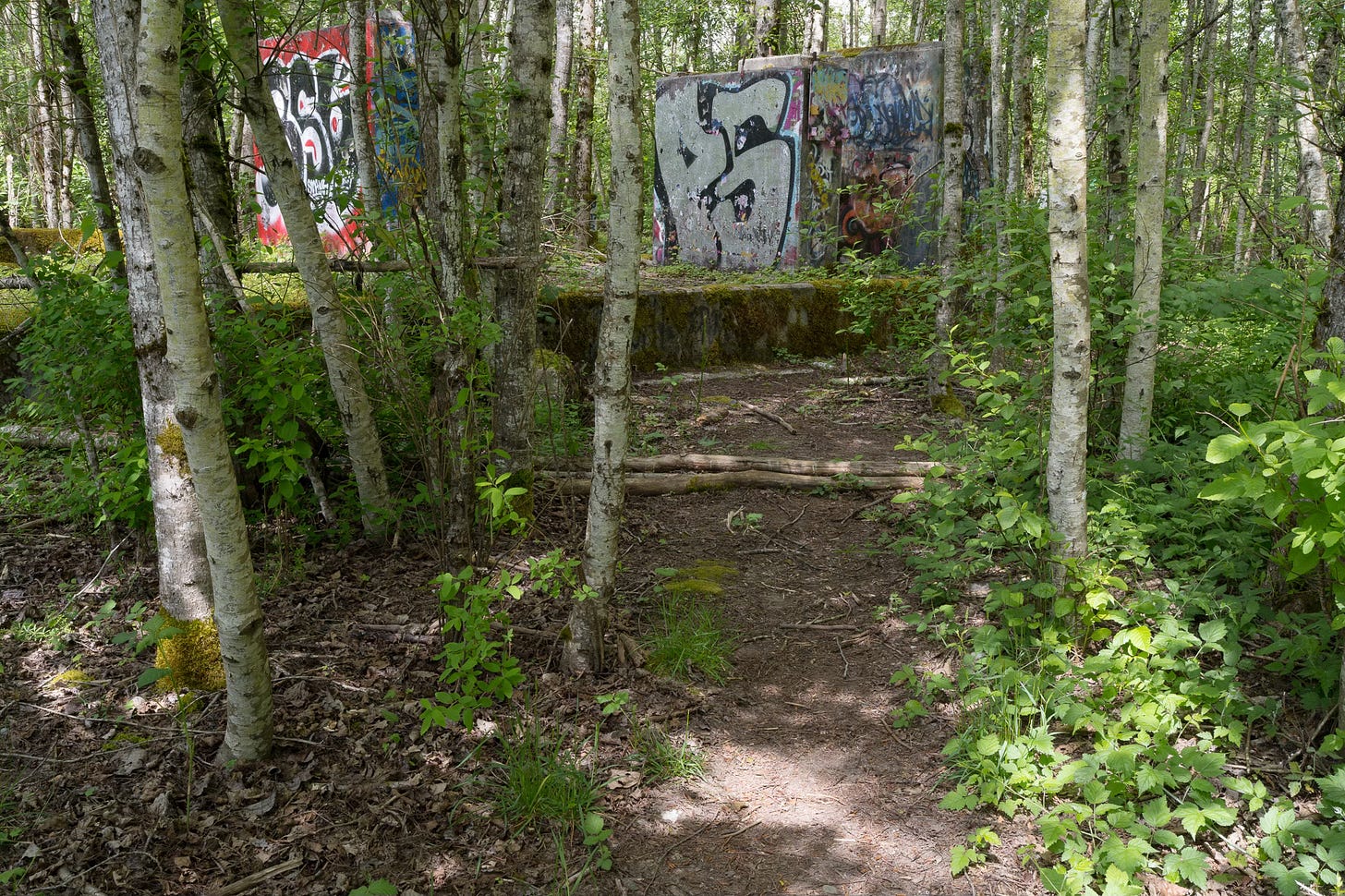
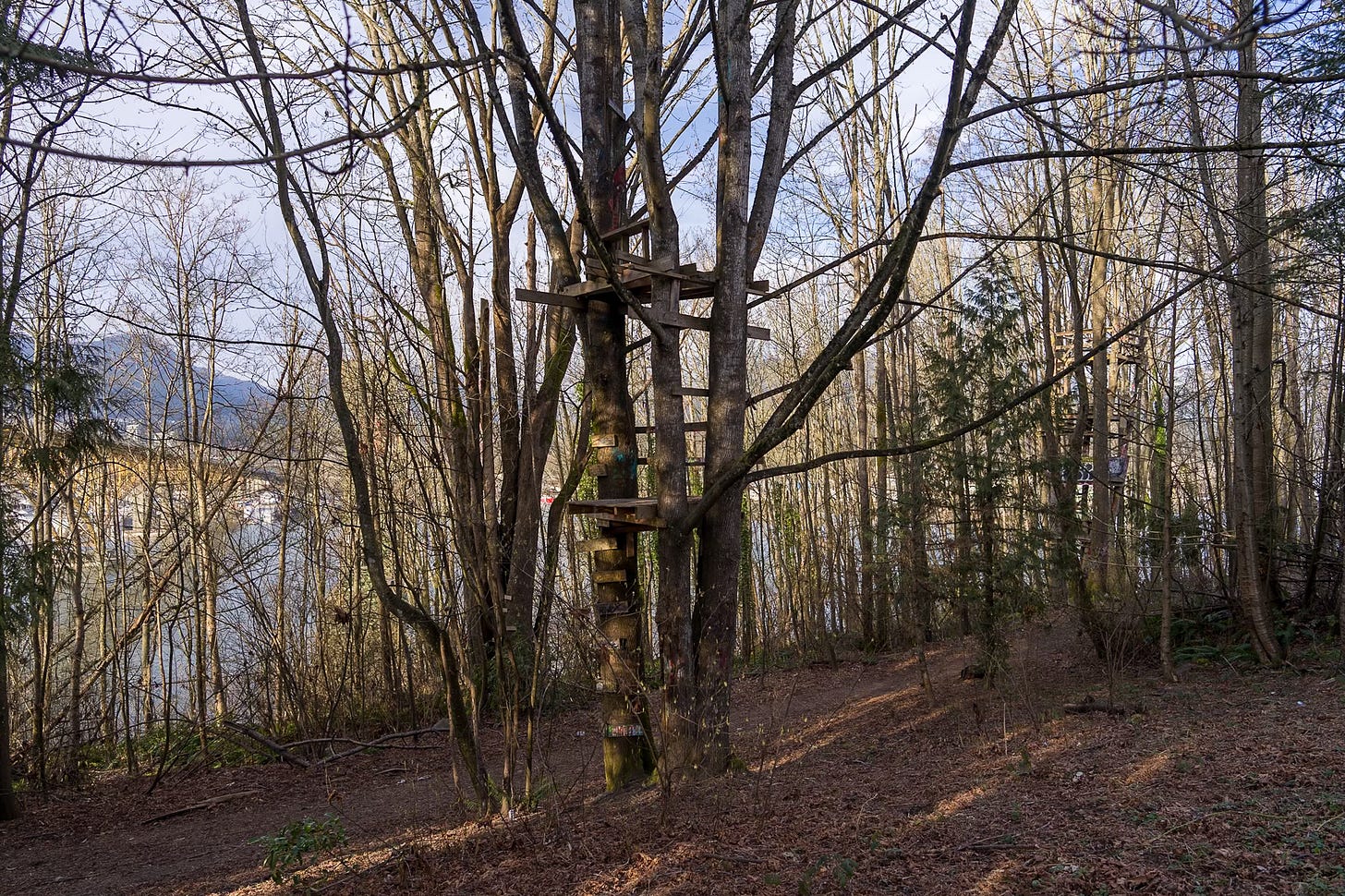
Fascinating Jim. You have sent me off on so many different tangents - I must go a write some of them down. Thank you.